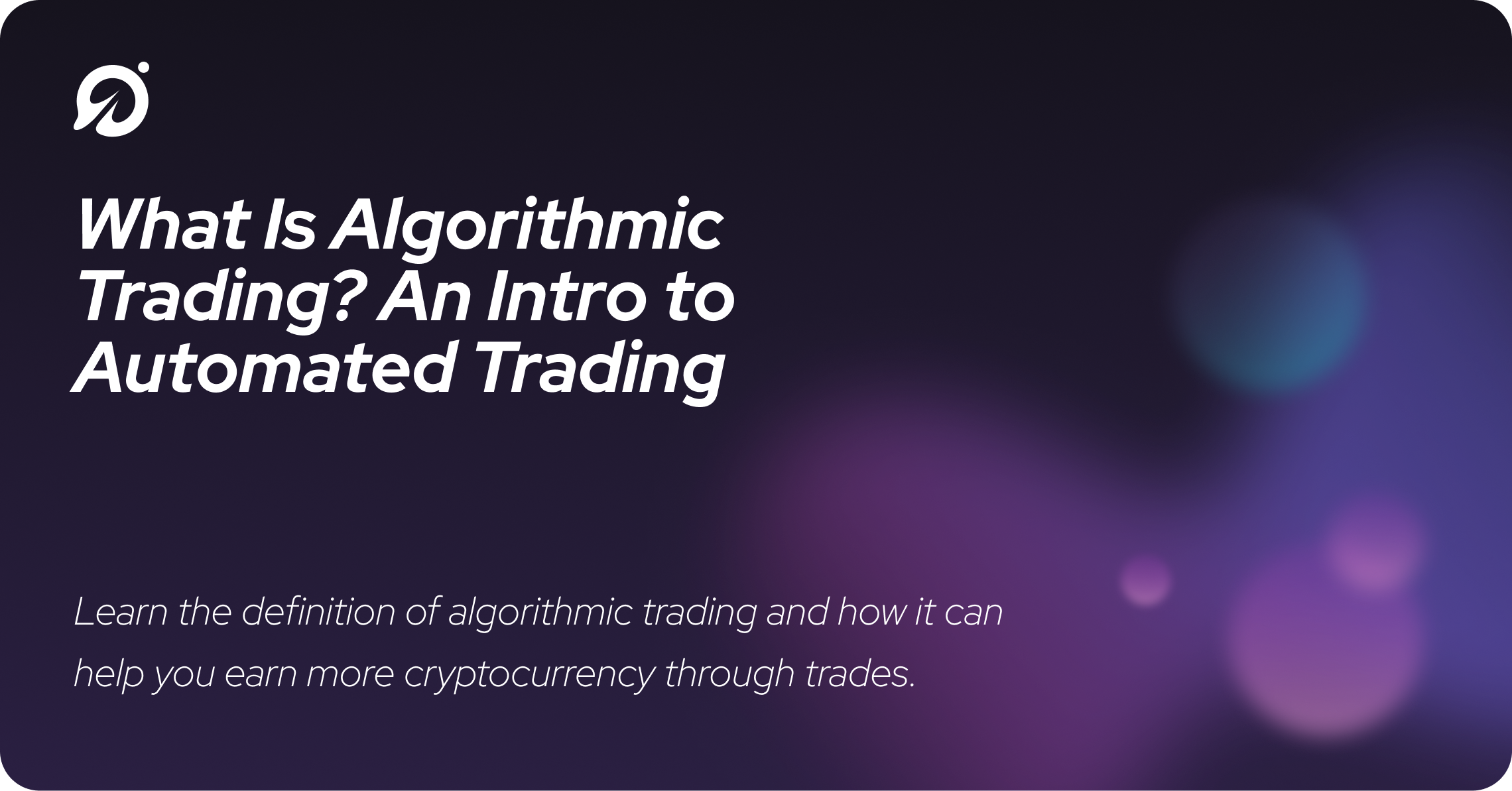What Is Algorithmic Trading? An Intro to Automated Trading
It’s no secret that trading is a complicated system. It’s also rife with volatility. And while many individuals are intelligent and experienced, sometimes you need abilities beyond human capability.

Disclaimer: This is for informational purposes and is not meant to serve as financial or investing advice.
Sometimes machines can be better than men. After all, financial markets are becoming immensely complicated. These ever-growing systems continue to impact the wealth of countless people.
As we’ll explore below, sometimes, humans alone just don’t have what it takes to reach the pinnacles of success in the crypto market. That’s where algorithmic trading (also known as automated trading) comes in.
Let’s talk about the realities of how algorithmic trading works. We’ll take you through every part of it, step by step, in an easy-to-digest manner.
Let’s get started.
What Is Algorithmic Trading?
Algorithmic trading (as we mentioned, it’s also known as automated trading) is when a computer program is used to make trades in financial markets. It follows an algorithm (thus the term “algorithmic” trading) to make decisions. And it can do so faster and more frequently than any person.
Algo trading methods use machine learning to help give hedge funds and investors a computational advantage on various trading platforms, from crypto markets to the Forex (foreign exchange market).
The computer algorithm looks at market data such as price, quantity, and timing to perform a technical analysis of market conditions and help with real-time decision-making.
One example is high-frequency trading, which is part of algo trading. This is where trading software oversees small orders into the market at very high speeds.
Like milliseconds or microseconds.
To put it in perspective, a millisecond is a thousandth of a second. And a microsecond is a thousandth of a millisecond.
Think how many microseconds have passed since you read that last sentence. And how many trades could be processed in that time?
What Are the Advantages of Algorithmic Trading?
There are numerous reasons why people place their trust in these machines to handle decisions within the financial markets.
Let’s explore some of them now.
Best Possible Prices
These trading algorithms are programmed to make timing a critical component. Price changes in the stock exchange are constant. Market participants with experience in live trading know that stock prices just don’t sit still. Making trades at the correct millisecond can help get you the best possible price.
There’s an old saying: time is money. It’s especially true in the world of cryptocurrency trading.
Lower Transaction Costs
Without needing those pesky humans to monitor everything at every moment, the algorithm can keep an eye on everything and immediately execute trades at the precise moment.
This saves both time and money. Thus, lower transaction costs.
Mitigation of Human Error
People are imperfect. Algorithmic trading systems don’t feature human conditions like fear, greed, errors in judgment, and fatigue.
Plus, remember that Wall Street is full of volatility. That can trip people up.
But trading algorithms? Not as much.
Instantaneous and Accurate Trading
Precise automation and no humans mean the risk of error sinks. Computers are quantitative machines, not emotional beings with souls.
Computers are also fast: they can quickly analyze various parameters and technical indicators.
The computers can also double-check the trade to ensure everything is on target. Accuracy is crucial for success.
Now that we’ve looked at the benefits let’s dig into algorithmic trading strategies.
What Are the Best Algorithmic Trading Strategies?
1. Arbitrage
Sometimes a currency is traded on two different exchanges, and there is a minor difference in the respective prices.
Arbitrage is when you take advantage of the error by buying the stock at one price on the first market and selling it at a higher rate on the second.
2. Index Fund Rebalancing
First, let’s define index funds. These investment funds follow a benchmark index, like the Nasdaq 100 or the S&P 500.
Le’s say you put money into an index fund. Those dollars are used to invest in all companies that comprise that specific index. The advantage is that it diversifies your portfolio.
So, now let’s talk about rebalancing. The portfolios of index funds are regularly adjusted to reflect updated prices of the fund’s underlying assets.
Rebalancing these funds allows the trading algorithms to take advantage of the expected trades, depending on the number of stocks in that particular index fund.
Computer systems can get the best prices, timely results, and low costs.
3. Implementation Shortfall
This is when a trader receives a different net execution price than intended. In other words, it is a time lag between making and executing a decision. Algo trading can help to reduce this.
4. Mathematical Modeling
Algorithmic traders predict how the value of stocks will change through mathematical models.
One such method is known as “mean reversion,” which analyzes the average (or “mean”) of a stock’s temporary low and high prices. When the current market price sits below the average price, then that stock becomes attractive.
Why? Because likely, the price will eventually increase based on the average price.
5. Trend-Following
Another term for this is “trend trading.” It’s when a trader analyzes the momentum of a particular stock related to its direction — up or down. When the price moves in one overall direction, that’s a trend.
Traders also use moving averages, trendlines, and technical indicators to help nail down the trend direction. This helps inform trades.
6. Time Weighted Average Price (TWAP)
This algorithm is set on the weighted average price, defined by criteria related to time. It's used for large trade orders.
When the value is calculated, the computer can break the large order into smaller orders at the TWAP price, giving it the best value.
The point of it? A massive order, not broken apart, could quickly increase the value of a particular financial asset.
7. Volume Weighted Average Price (VWAP)
This reveals the average price of an asset adjusted for its volume. The algorithm calculates this value during a trading session by taking the monetary value of trading in that asset and dividing it by the volume of trades.
This is another way of ensuring large orders do not disrupt the market.
8. Percentage of Volume (POV)
This algorithm is also based on volume and used to execute more oversized orders without impacting the market price.
It weighs sales to a stock’s percentage of trading volume over a specific period.
Algorithmic Trading FAQs
How Can You Learn Algorithmic Trading?
There are a variety of ways to learn about algo trading. We recommend learning more about our app, Pluto. We help you automate investing in stocks and crypto-currencies by building a portfolio of "strategies" or rules for when to buy and sell.
With Pluto, you can quickly build a portfolio of algorithmic trading strategies to watch your investments and make better decisions.
If you have any further questions, let us know!
Who Uses Algorithmic Trading?
The most common users of algorithmic trading strategies include major brokerage companies and institutional investors. They do it to save on costs that typically come with trading.
According to studies, algo trading is ideal for large orders that can make up to 10% of one’s overall trading volume.
What Programming Languages Are Best for Algo Trading?
The following software contains high-performance libraries (either external or part of their standard) for basic data structure and algorithmic work:
- C++
- Java
- Python
- R
Not familiar with these? We’ll be happy to share basic information about them. Just shoot us a quick message.
Is Algorithmic Trading Legal?
Yes, it’s 100% legal in the United States and many other parts of the world. At Pluto, we are very focused on following the law to the absolute letter.
We want to help you become wealthy through automated trading and do it in a transparent, ethical, and legal way. We wouldn’t have it any other way. But that doesn’t mean there isn’t serious oversight.
And we want to be completely open about that.
For example, let’s talk about the March 2010 “flash crash,” where in 10 minutes, the Dow 30 lost 1,000 points.
What happened?
Well, various trading algorithms reacted all at once to a market aberration.
As a result, “circuit breakers” are now in the United States. These regulations will temporarily stop trading in its tracks on an exchange if panic-selling occurs.
Hopping over to Europe, algorithmic traders must have a “kill switch” that can be used in the event of a malfunction.
Algorithmic trading is safe, effective, and legal. But we, of course, want to make sure to use it responsibly for all our clients.
How Does Algorithmic Trading Work in Crypto?
Algorithmic trading in cryptocurrency is similar to its use in the traditional stock market — the trading occurs all thanks to a computer program that makes use of algorithms. To get started with algorithmic trading in crypto, consider setting up a practice portfolio with Pluto.
From there, you can create your first strategy and can even find immediate help for your automated crypto trading.
With these tools, you can quickly gain a deeper understanding of how automated trading with cryptocurrency works.
The Bottom Line
Cryptocurrency is a growing phenomenon, and the technology exists to make the absolute most of it. While humans are very savvy, they simply can’t compete with the accuracy and speed of trading algorithms.
A program like Pluto can help you get the best prices, lower your costs, reduce the potential for human error, and get faster, more accurate trades completed to your financial benefit. We understand how successful trading works. It’s great for beginners and veterans alike.
But no matter what, we sincerely hope you have found this information about algorithmic trading strategies helpful.
Thanks for spending this time with us. We hope this article has provided you with some real value and grown your knowledge. If you’re curious to learn more, don’t forget about our other blog entries.
Sources:
Basics of Algorithmic Trading: Concepts and Examples | Investopedia
How Algorithmic Trading Companies Automate Their Investment Strategy | DataScienceCentral.com
Learn with ETMarkets: How can algo trading improve a trader's experience? | The Economic Times
Implementation Shortfall Definition | Investopedia
Algos - Guide to Algorithms Used in Trading Strategies | Corporate Finance Institute
Trend Trading: Definition and How Strategy Aims For Profit | Investopedia
Time-Weighted Average Price (TWAP): Introduction, Some Examples, and Calculations | QuantInsti
Volume-Weighted Average Price (VWAP): Definition and Calculation | Investopedia
Algorithmic Trading: Definition, How It Works, Pros & Cons | Investopedia
